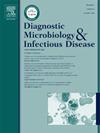芬兰1989-2024年新发长滩军团菌感染的检测、相关性和环境来源
IF 2.1
4区 医学
Q3 INFECTIOUS DISEASES
Diagnostic microbiology and infectious disease
Pub Date : 2025-03-06
DOI:10.1016/j.diagmicrobio.2025.116788
引用次数: 0
摘要
长滩军团菌是欧洲军团病的一种新发病因。我们分析了来自国家传染病登记处(NIDR)和军团菌参考实验室数据库的数据,以表征芬兰的长滩乳杆菌感染和诊断。1989-2024年共报告长滩杆菌病例41例,以园丁肺炎和手部伤口为主,2019年以后显著增加。病人访谈和环境取样将感染与堆肥、盆栽土壤或户外活动联系起来。全基因组测序(WGS)在3例病例中证实了相同的患者和土壤分离株,并在非相关分离株中发现了几个聚类。与其他军团菌引起的感染相比,长滩乳杆菌病例具有明显的特征,包括更高的中位年龄(64岁对56岁)、更高的病死率(15%对8%)、更多的肺外感染(12%对1%)和更高的女性比例(44%对35%)。患者和环境分离株的遗传亲缘性和高克隆性提示有共同的环境宿主。本文章由计算机程序翻译,如有差异,请以英文原文为准。
Detection, relatedness and environmental sources of emerging Legionella longbeachae infections in Finland, 1989-2024
Legionella longbeachae is an emerging cause of Legionnaires' disease in Europe.
We analysed data from the National Infectious Disease Register (NIDR) and the Legionella Reference Laboratory database to characterize L. longbeachae infections and diagnostics in Finland.
A total of 41 L. longbeachae patient cases, mainly gardeners’ pneumonias and hand wounds, were reported during 1989-2024, with a significant increase after 2019. Patient interviews and environmental sampling linked infections to compost, potting soil or outdoor activities. Whole genome sequencing (WGS) confirmed identical patient and soil isolates in three cases and revealed several clusters among non-related isolates.
Compared to infections caused by other Legionella species, L. longbeachae cases had distinct characteristics, including higher median age (64 vs. 56 yrs.), higher fatality (15 % vs. 8 %), more extrapulmonary infections (12 % vs. 1 %) and higher proportion of females (44 % vs. 35 %).
The genetic relatedness of patient and environmental isolates and high clonality suggest common environmental reservoirs.
求助全文
通过发布文献求助,成功后即可免费获取论文全文。
去求助
来源期刊
CiteScore
5.30
自引率
3.40%
发文量
149
审稿时长
56 days
期刊介绍:
Diagnostic Microbiology and Infectious Disease keeps you informed of the latest developments in clinical microbiology and the diagnosis and treatment of infectious diseases. Packed with rigorously peer-reviewed articles and studies in bacteriology, immunology, immunoserology, infectious diseases, mycology, parasitology, and virology, the journal examines new procedures, unusual cases, controversial issues, and important new literature. Diagnostic Microbiology and Infectious Disease distinguished independent editorial board, consisting of experts from many medical specialties, ensures you extensive and authoritative coverage.

 求助内容:
求助内容: 应助结果提醒方式:
应助结果提醒方式:


